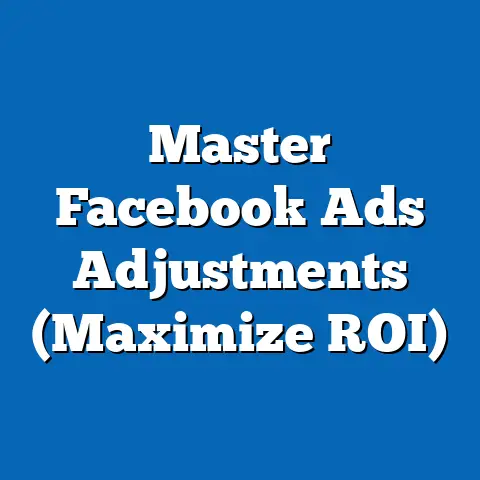Maximize fb ad Reach with Income Breakdown Strategies (Expert Tips)
The world of digital marketing is a constantly shifting landscape. What worked yesterday might not work today, and what works today might be obsolete tomorrow. Among the various platforms and strategies, Facebook Ads remain a powerful tool for reaching targeted audiences. However, simply running ads isn’t enough anymore. To truly maximize your impact, you need forward-thinking strategies that adapt to changing consumer behavior and increasing competition. That’s where income breakdown strategies come in.
In this article, I’ll dive into how understanding income segments can significantly enhance your Facebook ad targeting and reach. I’ll share expert tips on crafting campaigns that resonate with different income brackets, ensuring you’re not just reaching people, but connecting with them in a meaningful way. This isn’t just about demographics; it’s about understanding the nuances of how income influences consumer behavior and tailoring your message accordingly.
Understanding Your Audience
Audience segmentation is the bedrock of effective Facebook advertising. Gone are the days of casting a wide net and hoping to catch something. Today, precision is key. And one of the most powerful ways to achieve that precision is by understanding your audience’s income levels.
Income influences almost every aspect of consumer behavior, from the products people buy to the messages they respond to. A high-income individual might be drawn to luxury goods and exclusive experiences, while someone in a lower income bracket might prioritize affordability and value. Ignoring these differences is like trying to sell a yacht to someone who can barely afford a rowboat.
So, how do you gather demographic data, especially income insights? Facebook itself offers some targeting options based on income, but I’ve found that supplementing this with third-party data and market research can provide a much richer picture. Tools like Nielsen’s PRIZM or Experian’s Mosaic can provide detailed insights into consumer lifestyles and spending habits based on geographic location, which often correlates with income levels.
But data is just data until you give it meaning. That’s why creating detailed buyer personas is so important. These personas should go beyond basic demographics and delve into the psychographics of each income bracket. What are their aspirations? What are their pain points? What motivates their purchasing decisions? The more detailed your personas, the better equipped you’ll be to craft ads that truly resonate.
Takeaway: Understand that income levels significantly influence consumer behavior. Use a combination of Facebook’s targeting options and third-party data to create detailed buyer personas that reflect different income brackets.
The Power of Income Breakdown Strategies
Income breakdown strategies involve tailoring your advertising message and creative assets to specific income segments. It’s about recognizing that a one-size-fits-all approach simply doesn’t work in today’s diverse marketplace.
Think about it: a luxury car ad might feature sleek design and high-performance capabilities, targeting high-income individuals who value status and prestige. On the other hand, an ad for a budget-friendly car might focus on fuel efficiency, reliability, and affordability, appealing to those in lower income brackets who are more concerned with practical considerations.
I’ve seen firsthand how effective this can be. In one campaign I ran for a financial services company, we segmented our audience based on income and tailored our messaging accordingly. For high-income individuals, we focused on wealth management and investment opportunities. For those in lower income brackets, we emphasized budgeting tools and debt consolidation services. The result? A significant increase in conversion rates and a higher ROI compared to our previous, more generic campaigns.
But it’s not just about the products or services you’re offering. It’s also about the way you present them. Consider the language you use, the visuals you choose, and the overall tone of your ad. A high-income audience might respond well to sophisticated and aspirational imagery, while a lower income audience might prefer a more relatable and down-to-earth approach.
Psychographics play a crucial role here. Understanding consumer motivations tied to income levels can help you craft ads that tap into their deepest desires and aspirations. Are they looking to achieve financial freedom? Do they want to provide a better life for their families? Do they simply want to feel good about themselves? By understanding these motivations, you can create ads that speak directly to their needs and desires.
Takeaway: Tailor your advertising message and creative assets to specific income segments. Consider the language you use, the visuals you choose, and the overall tone of your ad. Understand consumer motivations tied to income levels to create ads that resonate on a deeper level.
Crafting Targeted Ad Campaigns
Now that you understand the power of income breakdown strategies, let’s talk about how to put them into practice. This involves setting up Facebook ad campaigns that specifically target different income segments.
First, you need to leverage Facebook’s audience targeting features. While Facebook’s direct income targeting options are limited, you can still use demographic data like education level, job title, and homeownership to infer income levels. You can also create custom audiences based on website traffic, email lists, and other data sources. By layering these targeting options, you can create highly specific audiences that align with your income-based buyer personas.
Here’s a step-by-step guide:
- Define Your Income Segments: Based on your market research and buyer personas, identify the specific income brackets you want to target.
- Create Ad Sets for Each Segment: In Facebook Ads Manager, create separate ad sets for each income segment. This allows you to tailor your messaging and budget for each group.
- Use Facebook’s Targeting Options: Utilize demographic data, interests, and behaviors to refine your audience targeting within each ad set.
- Craft Tailored Ad Copy and Visuals: Create ad copy and visuals that resonate with the specific needs and desires of each income segment.
- Set Your Budget and Bidding Strategy: Allocate your budget based on the potential ROI of each income segment. Consider using automated bidding strategies to optimize your ad delivery.
Dynamic ads and retargeting strategies can also be powerful tools for enhancing reach based on income data. Dynamic ads allow you to automatically show different products or offers to different users based on their interests and behavior. Retargeting allows you to re-engage users who have previously interacted with your website or ads, increasing the likelihood of conversion.
For example, if a user in a high-income bracket visits the luxury section of your website, you can retarget them with ads featuring your most premium products. If a user in a lower income bracket visits the sale section, you can retarget them with ads highlighting your most affordable options.
Takeaway: Set up separate ad sets for each income segment, using Facebook’s targeting options to refine your audience. Craft tailored ad copy and visuals that resonate with each group. Utilize dynamic ads and retargeting strategies to enhance reach based on income data.
Analyzing Performance and Adjusting Strategies
Launching a targeted ad campaign is just the first step. The real magic happens in the analysis and optimization phase. You need to constantly monitor your campaign performance and make adjustments based on the data you’re seeing.
Key performance metrics to monitor include:
- Conversion Rates: How many people are converting into customers from each income segment?
- Cost Per Acquisition (CPA): How much are you spending to acquire a customer in each income segment?
- Return on Ad Spend (ROAS): How much revenue are you generating for every dollar you spend on ads in each income segment?
- Click-Through Rate (CTR): How engaging are your ads for each income segment?
- Landing Page Conversion Rate: How well are your landing pages converting visitors from each income segment?
Facebook Insights and other analytics tools can provide valuable data on ad performance. Pay close attention to the demographics of your converters and identify any patterns or trends. Are certain income segments more responsive to your ads? Are certain ad creatives performing better than others?
I always encourage a test-and-learn approach. Don’t be afraid to experiment with different ad copy, visuals, and targeting options. A/B testing can be a powerful tool for identifying what works best for each income segment.
For example, you might test two different ad headlines for your high-income audience. One headline might focus on exclusivity and prestige, while the other might focus on investment potential. By tracking the performance of each headline, you can determine which one resonates more with your target audience and adjust your strategy accordingly.
Remember, the goal is to continuously refine your strategies based on real-time data. The more you learn about your audience, the better equipped you’ll be to create ads that truly resonate and drive results.
Takeaway: Monitor key performance metrics to track the performance of your income-based targeting. Use Facebook Insights and other analytics tools to gather data on ad performance. Adopt a test-and-learn approach to continuously refine your strategies based on real-time data.
Future Trends in Facebook Advertising and Income Targeting
The world of Facebook advertising is constantly evolving, and it’s important to stay ahead of the curve. Several trends may affect income breakdown strategies in the future.
AI-driven targeting is becoming increasingly sophisticated. Facebook is using artificial intelligence to identify and target users based on their behavior and interests, making it easier to reach specific income segments. As AI continues to evolve, it will likely play an even bigger role in ad targeting.
Changes in consumer behavior are also impacting the advertising landscape. The COVID-19 pandemic has accelerated the shift to online shopping, and consumers are becoming more discerning about the ads they see. Personalization is becoming increasingly important, and income-based strategies can help you create more relevant and engaging ads.
Economic factors can also play a significant role. During times of economic uncertainty, consumers may become more price-sensitive, making it important to adjust your messaging accordingly. By staying informed about economic trends, you can adapt your advertising strategies to meet the changing needs of your audience.
Ultimately, the future of Facebook advertising is likely to be more personalized, data-driven, and adaptable. By embracing income breakdown strategies and staying informed about emerging trends, you can position yourself for greater success in reaching diverse audiences.
Takeaway: Stay informed about upcoming trends in Facebook advertising, including AI-driven targeting, changes in consumer behavior, and economic factors. Embrace personalization to create more relevant and engaging ads. Adapt your strategies to meet the changing needs of your audience.
Conclusion
Maximizing your Facebook ad reach is no longer about simply throwing money at the platform. It’s about understanding your audience, tailoring your message, and continuously optimizing your strategies. Income breakdown strategies offer a powerful way to achieve this, allowing you to connect with different income segments in a meaningful way.
By following the expert tips I’ve shared in this article, you can craft targeted ad campaigns that resonate with your audience, drive results, and position you for greater success in the future of Facebook advertising.
Call to Action
Now it’s your turn. Take what you’ve learned here and implement these strategies in your next Facebook ad campaign. Stay informed about future trends in digital marketing, and never stop learning. The future of Facebook advertising is bright, and with the right strategies, you can achieve remarkable results.






